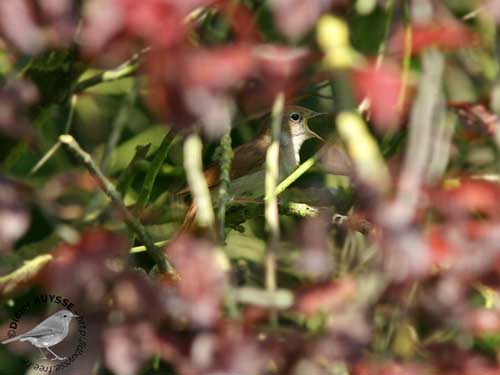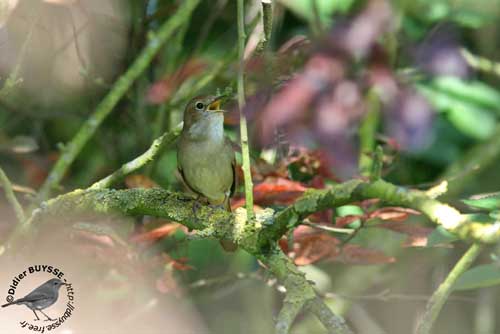
Fr: Rossignol philomèle
All : Nachtigall
Esp : Ruiseñor
Ital : Usignolo
Nd: Nachtegaal
Sd: Sydnäktergal
Photographers:
José Luís Beamonte
Pájaros de España
Didier Buysse
Vision d’Oiseaux
Jean Michel Fenerole
Photos d’Oiseaux du monde
Nicole Bouglouan
PHOTOGRAPHIC RAMBLE
Text by Nicole Bouglouan
Sources:
HANDBOOK OF THE BIRDS OF THE WORLD Vol 10 by Josep del Hoyo-Andrew Elliott-David Christie - Lynx Edicions - ISBN: 8487334725
THE HANDBOOK OF BIRD IDENTIFICATION FOR EUROPE AND THE WESTERN PALEARCTIC by Mark Beaman, Steve Madge - C.Helm - ISBN: 0713639601
BIRDS OF THE GAMBIA AND SENEGAL by Clive Barlow and Tim Wacher – Helm Field guides – ISBN: 0713675497
BIRDS OF THE MIDDLE EAST by R.F. Porter, S. Christensen, P Schiermacker-Ansen C.Helm - ISBN: 0713670169
ENCYCLOPEDIE DES OISEAUX DE FRANCE ET D’EUROPE – de Peter Hayman et Rob Hume - Flammarion – ISBN : 2082009920
L’ENCYCLOPEDIE MONDIALE DES OISEAUX - Dr Christopher M. Perrins - BORDAS - ISBN: 2040185607
THE COMPLETE BOOK OF BRITISH BIRDS – Written by “Royal Society for the Protection of Birds” experts - Préface de Magnus Magnusson - Michael Cady- Rob Hume Editors - ISBN: 0749509112
BirdLife International (BirdLife International)
Wikipedia, the free encyclopaedia
Common Nightingale
Luscinia megarhynchos
Passériforme Order – Muscicapidae Family
BIOMETRICS:
Length: 16-17 cm
Wingspan: 25 cm
Weight: 16-39 g
DESCRIPTION:
The Common Nightingale is usually located by its song, before to see the bird, often partially hidden in branches and foliage.
This species has acquired a place in folklore and culture of the countries where it breeds or it crosses when migrating. It is a symbol for poets. The song is considered as a form of poetry and often compared to famous pieces of music.
The Common Nightingale’s voice is the voice of nature, heard both in daylight and darkness. The beautiful notes and melodious phrases make its song remarkable, creative and spontaneous.

Both sexes are similar.
The adult of nominate race has plain warm brown upperparts, shading to rusty-brown on rump and tail. Flight feathers are washed rufous according to the light.
The underparts are pale buffy-white, with breast and flanks washed sandy-buff.
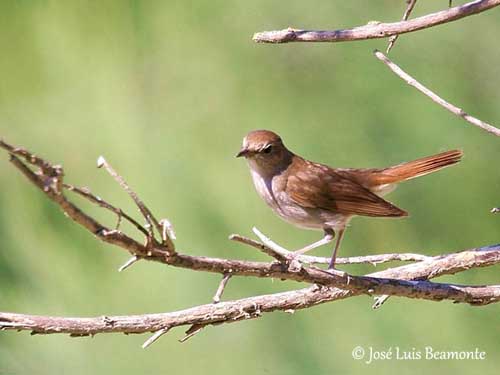
On the head, forecrown, crown and nape are rusty-brown. We can see indistinct pale greyish supercilium. Chin and throat are whitish.
The bill is blackish with pale pinkish base. The eyes are dark brown, surrounded by narrow whitish eyering. Legs and feet are flesh-coloured to brownish.
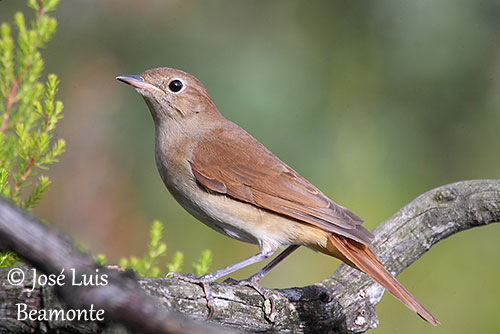
The juvenile is brownish with buff spotting on body and head. Rump, tail and flight feathers are rusty-brown. Bill, legs and feet are paler than in adults.
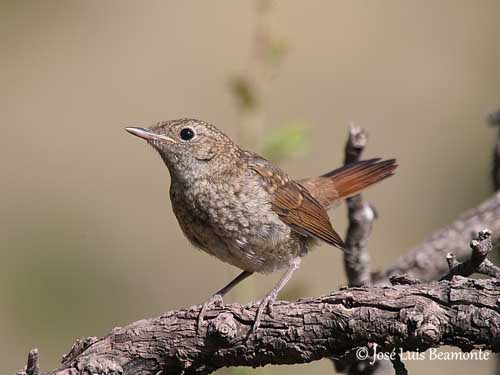
We can find three subspecies:
L.m. megarhynchos (here described and displayed), is found in NW Africa, W and C Europe, C Turkey and Levant. Non-breeding in Africa.
L.m. Africana if found in Caucasus area and E Turkey, N and SW Iran. Non-breeding in NE and E Africa.
This race is duller, less rufous above and paler below. Breast is mostly grey-brown.
L.m. hafizi is found in E Iran to Kazakhstan, SW Mongolia, NW China and Afghanistan. Non-breeding in E Africa.
This race is greyer above with whitish lores and indistinct supercilium. Underparts are whiter with sandy breast.
VOICE: SOUNDS BY XENO-CANTO
The Common Nightingale sings by day and night. The song is composed of loud, rich warbling whistles. There is a distinctive crescendo “lu-lu-lü-lü-lee-lee” which is a typical part of this song. It also includes clear and fluty phrases, bubbling, chirring, chattering…
It also utters series of long phrases “pichu-pichu-pichu-pichurrrrrr-chí” and variants.
The male sings during courtship, and this song is given near the nest, a bleating “hä-hä-hä-hä”. Both mates sing to keep in contact on their breeding territory. The Common Nightingale’s calls include raucous “krrr”, hard “tec-tec”, whistled “wiiit” or “wiiit-krrr” and harsh “kaarr”.
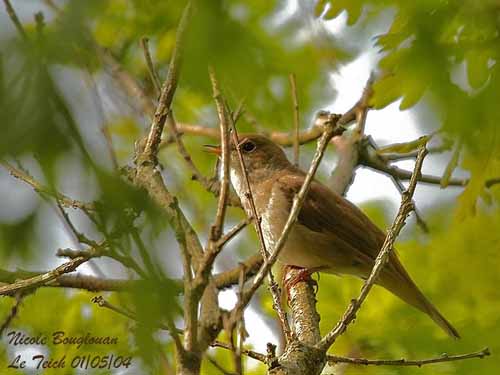
HABITAT:
The Common Nightingale frequents open woodland with thickets and dense patches of vegetation along water bodies, and edges of deciduous woodland and pine forest, and borders of dry areas such as garrigue and maquis.
It can be found in cultivated areas with hedgerows and bushes, in suburban gardens and parks with leaf litter.
This species usually occurs below 500 metres, but according to the range, it may be found higher, up to 1400-1800/2300 metres of elevation.
RANGE:
See above in “subspecies”
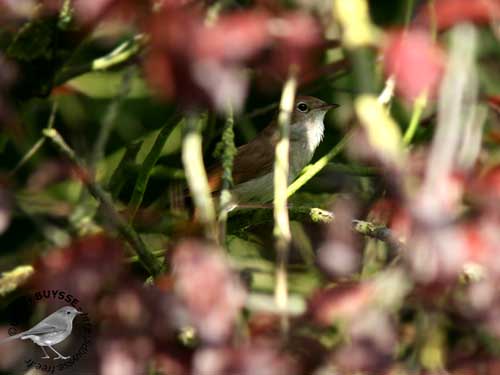
BEHAVIOUR:
The Common Nightingale feeds on invertebrates all year round, both on breeding area and wintering grounds. In late summer and in autumn, it also takes berries and seeds.
It forages on the ground in the leaf litter, usually within dense cover. It may also glean on low branches and leaves. It may occasionally hunt from perch by dropping onto the prey located on the ground, and may perform aerial sallies while pursuing an insect.
The Common Nightingale is often difficult to see, thanks to the brown plumage blending in branches and foliage. Fortunately, the long, broad rufous tail allows sometimes identifying the bird as it reaches the cover.
When feeding on the ground, it is always very active. The body is held slightly upright on long legs, and the bird hops with raised tail. It moves easily on the leaf litter with agile hopping movements while it flicks wings and tail. However, it may sometimes sing from exposed perches.
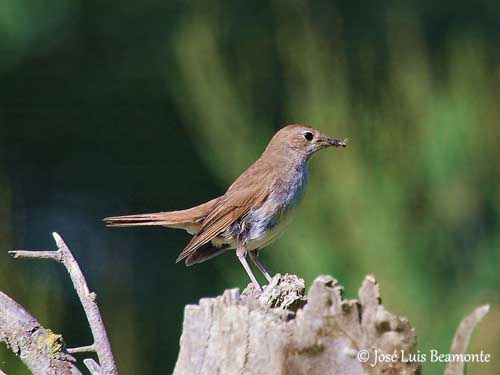
The Common Nightingale is territorial in its winter quarters and sings from cover, often in the morning.
During the breeding season, they usually return to the same nest-site every year. The male performs courtship displays. It sings softly close to the female while cocking and fanning the tail, and even sometimes dropping the wings. Some chases are reported too, during which the male pursues the female in whirring flight, while giving bleating calls “hä-hä-hä-hä”.
Then, it lands beside her, sings and dances with low head, fanned tail and quivering spread wings.
Courtship feeding by male to female occurs during the fertile period. It also performs “mate-guarding”, following its mate wherever she goes, perching just above her and watching the surroundings. This behaviour reduces extra-pair copulations.
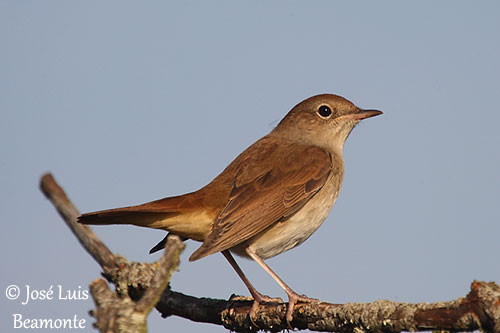
The Common Nightingale is migratory and winters in Africa, South of the Sahara, from Nigeria to Kenya and Tanzania.
The race “africana” winters mainly inland, whereas the race “hafizi” prefers the coasts. They remain until late March/early April.
The nominate race leaves the breeding grounds between late July and early September, and reaches the winter quarters in late October/early December. It returns to the breeding areas from early April to mid-May.
FLIGHT:
The Common Nightingale has low, flitting flight before to dive back into cover.
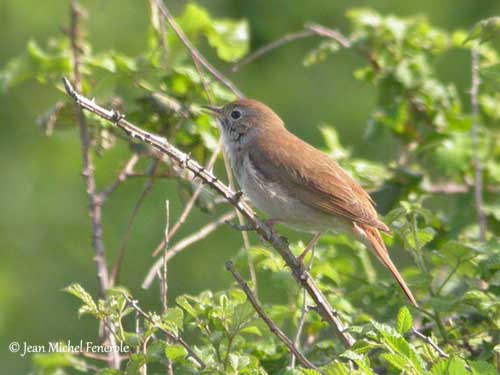
REPRODUCTION:
The breeding season varies according to the range, but occurs between late April and mid-July throughout Europe. This species usually produces two broods.
The Common Nightingale’s nest is often placed near the ground, below 50 cm, very well camouflaged among the leaf litter, at base of tussock or low grass. This is an open cup (but occasionally domed), a bulky structure made with dead leaves and grass. The inner part is lined with finer grasses, feathers and hair.
The female lays 4-5 olive-green eggs. Incubation lasts 13-14 days, by female fed by male during this period. The nesting period lasts about 10-12 days, then, the young birds disperse into the cover in the vicinity of the nest. They can fly 3-5 days later. They are fed and cared by both adults for 2-4 weeks more. The male often cares them while the female starts a second clutch.
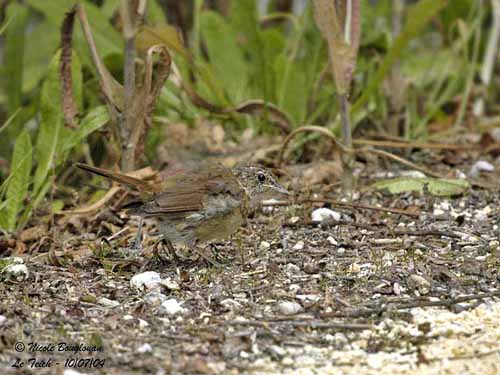
DIET:
The Common Nightingale feeds on invertebrates such as beetles, ants, caterpillars, flies, spiders and earthworms. It also takes seeds and berries in autumn.
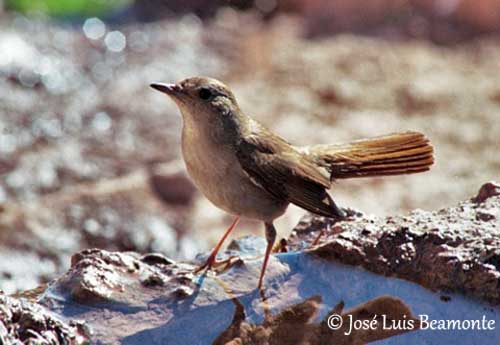
PROTECTION / THREATS / STATUS:
The Common Nightingale is abundant and populations appear stable and not currently threatened. However, some decline due to changes in the habitat may affect this species, especially in W Europe.
